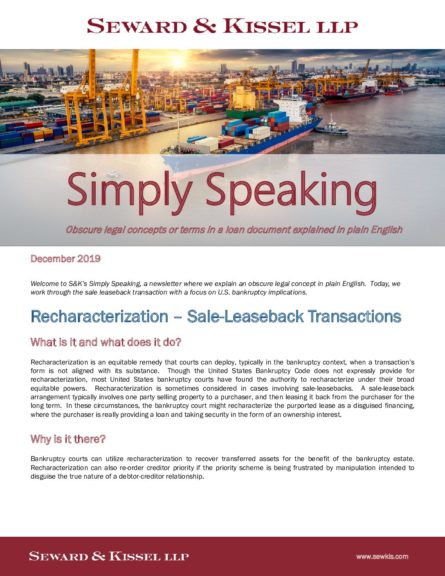
Simply Speaking (December 2019)
Recharacterization — Sale-Leaseback Transactions
What is it and what does it do?
Recharacterization is an equitable remedy that courts can deploy, typically in the bankruptcy context, when a transaction’s form is not aligned with its substance. Though the United States Bankruptcy Code does not expressly provide for recharacterization, most United States bankruptcy courts have found the authority to recharacterize under their broad equitable powers. Recharacterization is sometimes considered in cases involving sale-leasebacks. A sale-leaseback arrangement typically involves one party selling property to a purchaser, and then leasing it back from the purchaser for the long term. In these circumstances, the bankruptcy court might recharacterize the purported lease as a disguised financing, where the purchaser is really providing a loan and taking security in the form of an ownership interest.
Why is it there?
Bankruptcy courts can utilize recharacterization to recover transferred assets for the benefit of the bankruptcy estate. Recharacterization can also re-order creditor priority if the priority scheme is being frustrated by manipulation intended to disguise the true nature of a debtor-creditor relationship.
Why is it important (or not so important) to an owner-lessor?
Recharacterization can have a significant negative impact on an owner-lessor. If a bankruptcy court determines that a sale-leaseback is, in fact, a disguised financing, it would deem the leased property to be the property of the seller-lessee (i.e., the debtor), rather than the owner-lessor (i.e., the creditor). The property would then be subject to the automatic stay in the bankruptcy proceeding, which means the former owner-lessor would be prohibited from pursuing collection efforts throughout the pendency of the bankruptcy case (absent relief from the bankruptcy court). Furthermore, the purchase price paid for the property would be deemed a loan to the seller-lessee, limiting the owner-lessor to a claim for repayment against the bankruptcy estate. If the owner-lessor did not perfect a security interest in the property (which seems likely, given that the owner-lessor generally relies on title as security), that claim could be deemed unsecured. Unsecured claims are entitled to a low priority in a bankruptcy case, and often recover only cents on the dollar.
How does it affect a seller-lessee in practical terms?
In the recharacterization scenario discussed above, the seller-lessee would be identified as the “true” owner by the bankruptcy court and would be able to retain possession of the property, leaving the owner-lessor with a bankruptcy claim based on the amount of its “loan.” This may provide a significant benefit to the debtor (seller-lessee) and other creditors of the debtor’s estate (other than the owner-lessor, of course).
How is it relevant to shipping?
Sale-leaseback transactions, which have become a significant source of alternative financing for ship owners, take place frequently in the maritime sector through bareboat charter arrangements. If the party chartering the vessel (seller-lessee) under such an arrangement files for bankruptcy protection in the United States, the sale-leaseback may be challenged and the bankruptcy court would evaluate whether the charter represents a “true” lease or a disguised financing. This precise scenario played out in a U.S. maritime bankruptcy case. In American President Lines, Ltd. v. Lykes Brothers Steamship Co., 216 B.R. 856, 863-864 (M.D. Fla. 1996), the court examined a sale-leaseback transaction, and concluded that it should be recharacterized as a financing transaction. The ramifications were drastic as we have discussed. Since Lykes, recharacterization is often a threat in shipping bankruptcies, although it has not been recently litigated. Accordingly, all industry participants should be cognizant of the possibility.
Can the risk be mitigated?
Lessors engaging in sale-leaseback transactions can protect themselves by structuring the transaction to minimize the risk of recharacterization in the event of a charterer bankruptcy. Simply put, the transaction should be structured such that the indicia of ownership and the risk of loss are transferred to, and remain with, the owner-lessor. Another protective measure that parties can take is to attempt to perfect a security interest in the vessel. In the last several years, the Marshall Islands became the first flag state (with others following suit) to adopt a system where parties could record with the vessel registry their financing lease, which then will be treated as a preferred mortgage on their vessel. If an owner-lessor takes this route and a sale-leaseback transaction were recharacterized as a financing, the owner-lessor might be deemed to have a perfected security interest in the vessel and could be treated as a secured lender entitled to recover the full value of its collateral in the bankruptcy of the seller-lessee (as opposed to an unsecured creditor solely entitled to recover its pro rata share of unencumbered assets). This system remains untested, however.
Questions?
Please contact any member of S&K’s Maritime Practice Team.